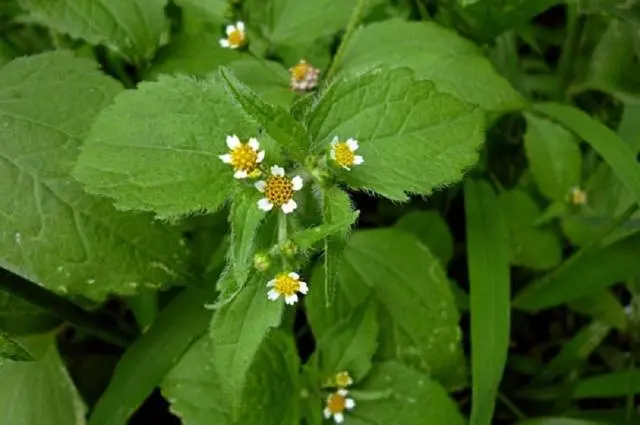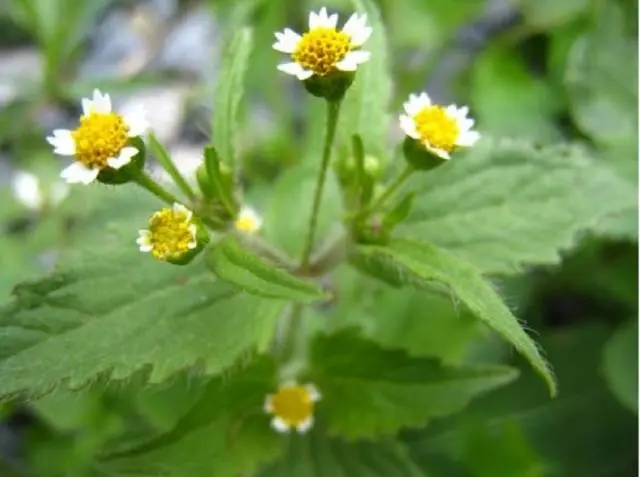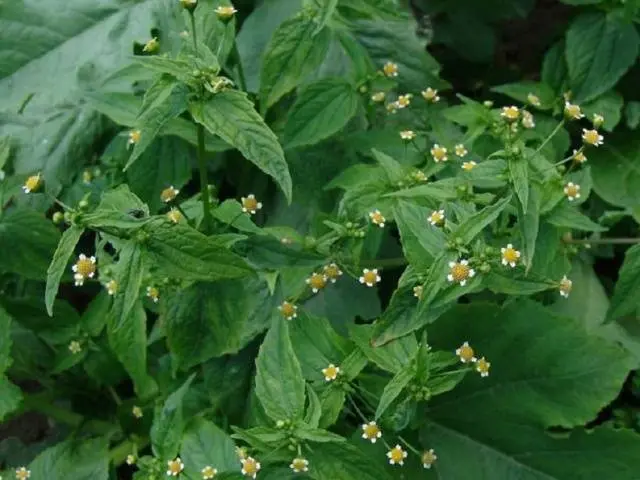Among the requirements of agricultural technology of any crops, weeding is an important point. This is due to the presence of a huge number of weeds that can drown out plants or become a carrier of diseases. Often, it is weeds that are the breeding ground for pests and parasites that annoy during the growing season of cultivated species.
Every year summer residents observe more and more new “green residents” on their plots.
One of these uninvited guests was the American weed. The homeland of the plant is America, so the popular name has taken root. Deliveries of seeds from other countries are very profitable. They expand the range and variety types of cultivated crops, but along with them come across seeds of weeds from the same area. Thus, the American weed was introduced.

The plant also has a scientific name, which is known throughout the world – small-flowered galisonga from the aster family. Belongs to the group of annual spring crops.
Description of the weed
The homeland of the American is South America. Among the main characteristics it should be noted:
- Shade tolerance. Galisonga can grow not only in lighted areas and fields, but also in parks, gardens, almost on any soil. Of course, fertile and loose soil with good moisture is more attractive to weeds.
- Fertility. American weed strikes with its ability to reproduce. It can produce up to 20 thousand seeds per season. However, their germination does not exceed forty percent and germination is difficult at a seed embedment depth of more than 2 cm. Therefore, the American weed compensates for this shortcoming with the striking ability to grow with stems. Roots emerge from internodes. If the seeds fall into the soil, then their germination persists for 10 years and does not depend on climatic changes (waterlogging, frost, drought). Shoots appear in spring, throughout the summer season and in autumn.
- Vitality. Gardeners note the unsurpassed vitality of the American weed. The plant, even after being removed from the soil, is able to continue to live in the depths of compost heaps, lying on top of the ground and trapping moisture from the air with its leaves. Moreover, if there is enough moisture, then the American weed blooms and gives seeds while being among the weeded grasses.
These qualities allowed the American weed to become a formidable enemy of plantings in all regions. The absence of pests capable of destroying the American weed on soils also turned out to be very beneficial. He is not even afraid of aphids and fungal infections that plague almost all cultural plantings. In addition, galisonga suppresses the “habitual” weeds common in the regions – quinoa, gauze, sow thistle, wood lice. The only ones who are able to resist the invasion of the American are nettles and gout. Perennials with a powerful rhizome are not amenable to the invasion of the formidable American. Even mowing does not get rid of the halisonga for a long time. Therefore, it is very important to know how to deal with a hardy weed.
Galisonga is a weed growing up to 70 cm tall with an upright stem and small white flowers.

The leaves have short petioles and are lanceolate in shape. Flowers female, hairy achenes, tetrahedral. Seeds of an American are carried by means of flyers over a long distance and are able to ripen on a plucked plant.
Gardeners note the difficulty of weeding this weed. At the time of removal of the American, roots are pulled out and a number of growing crops. This is due to the fact that the weed has a branched root system and penetrates the roots of nearby plants.
How to deal with hardy weeds
With such a phenomenal American ability to survive, gardeners are wondering how to deal with weeds. They are based on the biological characteristics of the weed. How to get rid of a settled American woman on the site?
Effective methods to deal with an American woman include:
- Regular site inspection. This will allow you to notice the appearance of an American woman in time and take appropriate measures. As soon as the first young plants are noticed, they are immediately ruthlessly removed from the root.
- Mulching. Like any grass, the American needs light. Therefore, covering the free areas of the site with cut grass, cardboard, paper or other mulching materials, you do not allow it to grow and multiply freely. Lawn grass helps a lot. On the site of the lawn, the galisonga spreads very weakly, so you should not leave a lot of free places on the site. Cover the beds after harvest. Thus, you will get rid of not only the American, but also other weeds.
- Weeding. The destruction of the weed is unthinkable without its removal. An American is recommended to dig out, not to pull out. The remaining pieces of the root easily sprout. This event should be carried out as early as possible, before the flowering of the American. If you miss this period, then this method of getting rid of the weed will be ineffective. Seeds will fall into the soil, and their mass germination will be ensured. But even in this case, regularly weed out malicious plants.
- Removal from site. Even shredded weed should not be placed in a compost heap. It is impossible to trace the entry of seeds into the soil, so it is better to prevent this possibility. Mowing the galisonga is useless. This gives a temporary effect, it is better to uproot and burn.
- Sowing green manure. The American very quickly populates empty lots. If it is not possible to sow lawn grass or you will need this area in the future for planting, then use green manure. They will perfectly nourish the soil, improve its structure, and provide nutrition to beneficial microorganisms and worms.

Additional recommendations include:
Не стоит увлекаться гербицидами. До посадки культурных растений можно обработать начальные всходы сорняка. Но потом американка быстро привыкает к действию препарата. Вам придется в течение сезона постоянно менять используемые гербициды, да и почва будет напитана химическими веществами. Поэтому при небольшом распространении сорняка, примените гербицид, а затем больше положитесь на агротехнические методы борьбы.
If you’ve been in a weed-infested area, thoroughly clean your tools, shoes, and clothing. Even a minimal amount of seeds will turn your site into a new home for the galisonga.
Many gardeners use galisonga for medicinal purposes and as greens for salads. Weed roots contain polyacetylene compounds, leaves – flavonoids, saponins, inulin, tannins. Therefore, the use of American galisonga for medicinal purposes is very widespread. It is used in the treatment of the thyroid gland, anemia, ascites, helps with scurvy and stomatitis. Well normalizes blood pressure and stops bleeding.

Without consulting a doctor, an American should not be used even with stomatitis. Be attentive to your health.
In the photo – a cheerful weed galisonga:










